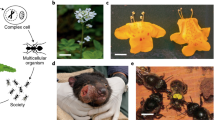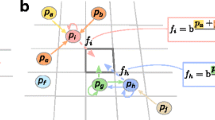Abstract
EVOLUTIONARY theory has not explained how competition among lower level units is suppressed in the formation of higher-level evolutionary units1,2. For example, the key problem of early evolution is how small, individual replicators formed cooperative groups of sufficient complexity to allow accurate copying of the genetic material3. The puzzle is why parasites did not subvert the formation of cells by obtaining benetics benefits from the group without contributing to shared traits that enhance reproduction4. These parasites would outcompete other replicators within the cell, disrupting reproductive fairness among subunits and destroying the functional coherence of the group. A similar problem arose at a later evolutionary stage with the orderly mendelian segregation of subunits (chromosomes) within cells, and reproductive fairness continued to be a problem in the evolution of insect5 and human societies6. Here I present a simple model to show how reproductive fairness evolves among subunits to create functional coherence and higher-level units. Self-restraint, which evolves according to the kin-selection coefficient of relatedness, is not sufficient: mutual policing and enforcement of reproductive fairness are also required for the evolution of increasing social complexity.
Similar content being viewed by others
References
Wilson, D. S. & Sober, E. J. theor. Biol. 136, 337–356 (1989).
Maynard Smith, J. & Szathmáry, E. The Major Transitions in Evolution (Freeman, New York, 1995).
Eigen, M. & Schuster, P. The Hypercycle: A Principle of Natural Self-Organization (Springer, New York, 1979).
Maynard Smith, J. Nature 280, 445–446 (1979).
Ratnieks, F. L. W. & Reeve, H. K. J. theor. Biol. 158, 33–65 (1992).
Alexander, R. D. The Biology of Moral Systems (Aldine de Gruyter, New York, 1987).
Frank, S. A. Proc. R. Soc. Lond. B 258, 153–161 (1994).
Bremermann, H. J. & Pickering, J. J. theor. Biol. 100, 411–426 (1983).
Lloyd, W. F. Two Lectures on the Checks to Population (1833, reprinted by Augustus M.Kelley, New York, 1968).
Hardin, G. Science 162, 1243–1248 (1968).
Hardin, G. Living within Limits: Ecology, Economics and Population Taboos (Oxford Univ. Press, 1993).
Ratnieks, F. L. W. & Visscher, P. K. Nature 342, 796–797 (1989).
Hurst, L. D. Proc. R. Soc. Lond. B 258, 287–298 (1994).
Wilson, D. S. & Sober, E. Behav. Brain Sci. 17, 585–684 (1994).
Bonner, J, T. The Cellular Slime Moulds 2nd edn (Princeton Univ. Press, 1967).
Morrissey, J. H. in The Development of Dictyostelium discoideum (ed. Loomis, W. F.) 411–449 (Academic, New York, 1982).
Williams, J. G. et al. Cell 59, 1157–1163 (1989).
Ozaki, T. et al. Development 117, 1299–1308 (1993).
Maynard Smith, J. Evolution and the Theory of Games (Cambridge University Press, Cambridge, 1982).
Price, G. R. Nature 227, 520–521 (1970).
Hamilton, W. D. Nature 228, 218–220 (1970).
Author information
Authors and Affiliations
Rights and permissions
About this article
Cite this article
Frank, S. Mutual policing and repression of competition in the evolution of cooperative groups. Nature 377, 520–522 (1995). https://doi.org/10.1038/377520a0
Received:
Accepted:
Issue Date:
DOI: https://doi.org/10.1038/377520a0
- Springer Nature Limited
This article is cited by
-
Functional properties of ant queen pheromones as revealed by behavioral experiments
Behavioral Ecology and Sociobiology (2023)
-
Conserved worker policing in African carpenter ants with drastically different egg chemotypes
Evolutionary Ecology (2023)
-
Host control and the evolution of cooperation in host microbiomes
Nature Communications (2022)
-
Unexplained cooperation
European Journal for Philosophy of Science (2021)
-
In silico bacteria evolve robust cooperation via complex quorum-sensing strategies
Scientific Reports (2020)





